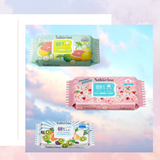3 Japanese Beauty Foods for Healthy Skin
Posted on January 14 2019
3 Japanese Foods for Healthy Skin

''You are what you eat''
This ancestral phrase keeps proving true as scientific and technological innovations help us deepen our understanding of the human body. Basically: what you ingest has an impact on what you look like - something to do with how your body proceeds vitamins, proteins, but also sugars and carbs.
You have certainly heard of ''beauty foods(Superfoods)'' before. The trend was initiated a few years ago but it has been a much more ancient mindset in many communities. This approach acknowledges food’s potential in impacting your skin and hair. Too much of one thing, or not enough of another, can all lead to imbalances, breakouts, dullness, and puffiness. While the right amount of specific foods can lead to a clearer complexion, tighter pores, smoother texture and many more benefits.
Understanding the impact that your diet has on your skin and hair can result in greatly appreciated savings of time and money. We know for a fact that the composition of your sebum varies according to the nutrients that your liver receives and processes. This is how important it is to have a diet that reflects what you want for your healthy hair and skin.
And we J-beauty lovers are so lucky, because Japan is all about skin-friendly foods. If you are not familiar with food talk there, you would be surprised to often here ‘’this does this or that to your skin’’ when discussing a specific meal with a friend. I’ve selected for you, 3 of the best skin-friendly Japanese foods with a bunch of health and beauty benefits that you can easily find in any Asian grocery store.
1. Tofu

Behind this very humble, white, innocent aspect hides a tremendous power. Such a common ingredient hides such surprising effects! It’s main ability is to prevent aging. It’s full of vitamin E and proteins which support cell regeneration and skin elasticity as well as….cue dramatic pause… the toning of facial muscles.
Add daily tofu intake to your morning face yoga practice, and you’re set to postpone the emergence of your wrinkles to the next decade. But the best part about tofu is that you can eat it in so many different types of recipes! You can eat it boiled, in a stew, fried, or raw with sesame oil and other seasonings. While I love tofu, I have to admit that Mother Nature provides us with many other foods that have a lot more flavor. But it is actually another pro: it means you can just mix and match it however you like. For instance, I like to have it boiled or slightly fried with green vegetables. With natto and tofu alike, try to consume GMO-free.
Tofu also contains saponin, a great exfoliant. It makes it the perfect go-to ingredient for all your DIY beauty recipes. There’s a reason why it was chosen by Shiseido to add value to their youngest brand, Waso. A rising star of the beauty industry, it was selected by trend forecast agency, WGSN, as one of the most promising ingredients of 2020.
There is no other proof needed that beauty has become a whole lifestyle: consumption, habits, communities and now diet. Food has been thought of as a source of beauty for centuries, Hippocrates himself used to say ‘’Let food be thy medicine’’. As J-beauty lovers, it’s the perfect opportunity for us to dive a little more into Japanese culture by exploring their relationship to food and how they always conceive it as an ally to beauty, to health, and to life.
2. Natto
Whenever you want to achieve beauty from within, fermentation is an obvious way to go. Natto is a rather controversial meal made of fermented soy beans. Controversial not for its social or environmental impact, but mainly for its taste (strong) and pungent smell (stronger). Either you hate it or you love it, there is no indifference towards natto (I hate it, most of my friends and family in Japan love it). But there is one thing that both sides agree about: it is one of the best anti-aging food there is.
Natto has a groundbreaking impact on health and helps human beings live longer and better by preventing heart diseases, osteoporosis or other conditions.. But let’s focus on what it brings to skin since that is why you come to us.
Its rich content of vitamin C makes it a powerful antioxidant, which protects from free radicals and external aggressions. It contains the 8 essential amino acids that the body needs to reach optimal functionality as well as many other agents whose main job is to purify your blood (remember, your skin depends a lot on how your body processes what you eat).
I know that we are all obsessed with collagen and HA (Hyaluronic acid) but research starts to show that the polyglutamic acid contained in natto is a great alternative for hydration as it can retain even more water than the latter two.
3. Konjac (Konnyaku)

You know the sponge, but do you know the food? Konjac was one of my most surprising culinary discoveries when I first moved to Japan. It was a very weird, brown, jelly-like thing floating in my stews, with a chewy texture, and I just thought ‘’why on Earth do we eat this?’’. Little did I know about the health-boosting benefits of this little root.
An enemy of cholesterol and an advocate of sugar control, konjac does an amazing work at treating acne thanks to its positive prebiotic properties. This means it helps good bacteria proliferate, all while preventing the proliferation of harmful skin bacteria. It also helps with restoring the barrier of sensitive skin to a normalized state, accelerating the skin’s natural wound and scar healing process.
Konjac is great because you can have it every day if you want to - unlike many harsh acne treatments that require an endless list of precautions of use and sun-bans. It’s spongy and brown and transparent, which makes it a little scary to try, but be brave and go for it, you won’t regret it.

Nawael
An enthusiast of skincare, blazer jackets, cute animals and food,
she’s passionate about the questions related to beauty with
its dynamics and perceptions especially in Asia. Former fashion and beauty editor in Seoul, she is now based in Paris.



